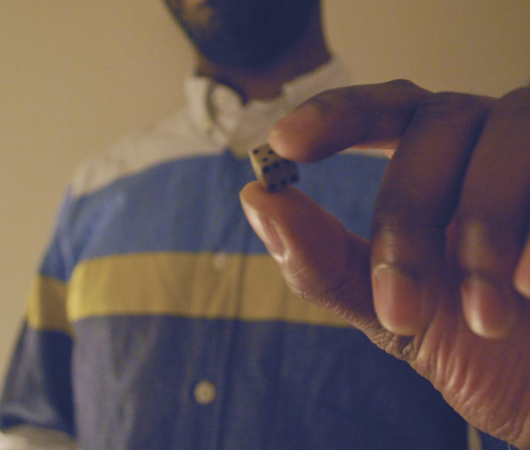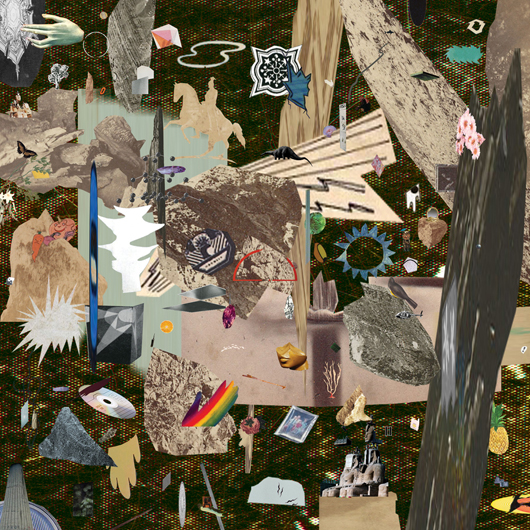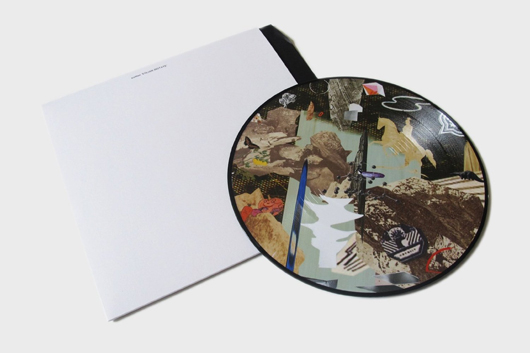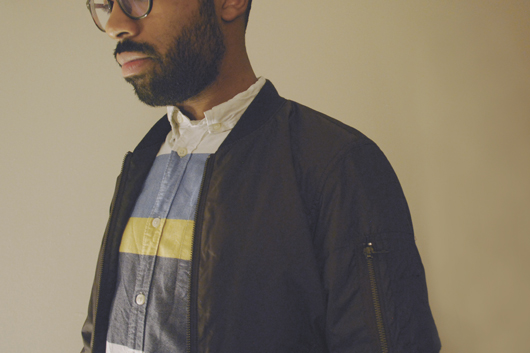A Generous Environment: Thoughts, Ideas, and Questions from patten
patten is a different kind of artist. Case in point: He isn’t satisfied being labelled […]

A Generous Environment: Thoughts, Ideas, and Questions from patten
patten is a different kind of artist. Case in point: He isn’t satisfied being labelled […]

patten is a different kind of artist. Case in point: He isn’t satisfied being labelled with such a specific title. He’s the kind of, let’s say, instigator who embraces the idea of a “compositional decision made by chaos,” crafts a playlist of silent songs, answers interview questions with Wikipedia links, and uses Twitter to repeatedly post a black-and-white photo of a rock in a person’s hand (not to mention follow the accounts of Disney, Lamborghini, MySpace founder Tom Anderson, Massive Attack, Oprah Winfrey, and the British Neuroscience Association, to name a few). patten’s given name is known to the public only as D, and that includes everyone who works with him at Warp, his new label home. Calling the Londoner elusive, anonymous, or enigmatic would be missing the point, though; his main interest is making us consider and possibly rethink many of the common perceptions and practices that we regularly take for granted.
ESTOILE NAIANT

But for all of his idiosyncrasies, patten does indeed write, record, and release music, and quite compellingly unique electronic music at that. His “official” debut album for No Pain in Pop, GLAQJO XAACSSO, refracted lush ambient sounds and raw techno into a contorted monolith that resonated with fans of Actress and Autechre, and even went on to land the 29th slot on XLR8R‘s list of the best releases of 2011. Yet it wasn’t until the end of 2013 that we heard from patten again, when he announced the he’d signed with Warp to release an EP and an LP in the coming months. The five-track EOLIAN INSTATE record arrived just before the New Year, and was followed this week by patten’s equally mystifying sophomore album, ESTOILE NAIANT (listen to it here). It’s a record that further explores the freeform stylistic ideas of GLAQJO XAACSSO, and is unafraid to fall head first down the rabbit hole into smeared abstractions and dense, impossible collages of sound. The 10-track LP—complete with all of its encrypted concepts, bewildering production work, handcrafted artwork, and, yes, intriguing music—begs to be dissected and discussed at length, so we sought out patten to speak with him about it.
In person and in casual conversation, D is an affable and forthcoming guy, quick to make a lighthearted joke or chat about books and TV shows. However, interviewing D about the work he does (whether it be his patten “project” or Kaleidoscope, the—for lack of a better term—label which he runs) is something else entirely. He has a far more philosophical and existential approach to thinking and talking about music, art, and all of their trappings than most creative people would let on, and that perspective makes for inherently unusual—and, to be sure, unquestionably stimulating—discussions. So, in an effort to maintain patten’s singular viewpoint, we’ve eschewed the typical Q&A format to allow him to speak purely in his own words. The following series of quotes is taken from two separate meetings we had with D while he was in Manhattan and Brooklyn for a series of performances in early January 2014, and we’ve presented them with header titles in order to give readers a certain amount of context.

On the Intent of the patten Project
“It doesn’t start with the perception of the audience as its endpoint. That’s the not the ignition of the creative act. There are other kinds of inspirations, concerns, and motivations behind producing things in the first place.”
“One of the aims is to be free from restriction as much as possible, even one’s own restrictions. Trying to find methods of working that are even free of my own tastes and my own restrictions of what I think is possible, what could make sense, is really key—to try to reach outside of my own perceptions, my own habits, my own sort of limitations as a mind. And in doing so, finding these methods and being faced with what is produced, extending and expanding one’s own perception of what can be. It’s a sort of dialoguing with the unknown.”
“Across the whole project, there’s a kind of clear decision to explore specific environments and use all of the different forms available—artwork, interviews, a Twitter feed, a JPEG, whatever. The idea is not to waste any of those potential spaces, to communicate in a vital and exploratory way. It’s all specifically considered.”
“I think that the sentiment behind all of these kinds of gestures is one of generosity. It’s a genuine desire for exploration and stimulation of dialogue and thought and creative activity on the part of users, if you like.”
On the Various Facets of the patten Project
“It varies from project to project, but I would describe [the visuals] as a kind of collaboration. I produce the music and the visuals are made in response to the music—as it’s being developed, as well. It’s not the case of presenting a finished record to someone, and they just kind of go away and give something back. It’s much more back and forth than that, so in the process of the music developing there are kind of keywords, specific textural sensitivities that are drawn out in the visuals.”
“There really are no limits. There are no limits to what might be made musically, visually, and in all sorts of different forms, and still be very much a part of the project. You have to remember also that the things that have been made public are only one facet of what’s going on. As well as Jane [Eastlight] working on the visual side, there are other people. People who are more interested in, like, the neuroscience side of things. So there are all sorts of different things going on that may take the form that is public domain, or may not, at different points.”
“In the project, there’s a fascination with objects that are being made and how they might create the circumstances by which one could be creative in their interfacing with those images, those sounds, those kind of real-time experiences with a live performance. What could a piece of music do when someone is walking along the street with it directly in their ears? What could it do when it’s pounding on their chest in a dark space? How can one form move between these different spaces? What characteristics could it accrue as it moves from headphones into a club space, into a seated theatre, into a research paper, into text, into conversation, into a garment, into a color or a combination of two colors, into a texture, into a single word or combination of words, into a spatial dynamic… It’s open, and I think that’s really important.”
EOLIAN INSTATE EP

On patten as an “Artist”
“I think those terms—musician, artist, producer, philosopher, writer, creative—they’re categories that don’t always necessarily reflect the reality of what it is that’s happening behind someone’s practice. I think, again, it’s this idea of openness and lack of willingness to accept set standards for doing things just because they’re there. It’s not non-conformity—that sounds really antagonistic, and it’s not antagonistic—but the lack of desire to just accept the way things are and the way things are done.”
“I never really consider work to be ‘finished,’ as such. I think it comes back to the idea of records being like a fixed moment in the development of something. It’s not necessarily even possible to distinguish between one piece of music and another piece of music, and think of them as kind of separate entities.”
On the Idea of Music
“It has a function, and it’s very present in all of our lives. It comes to you, music. It exists in time. Records exist, CDs exist, and MP3s exist, actually as things. All of these things exist and are real. However, music is something else. It’s hard to say where music is and where music happens. And it’s something that’s very interesting, whether it happens inside your mind or if it happens in the kind of encoded objects. Is that the music, the record or the CD, or is it the physical phenomena in the air? Is it the chemical reactions that are taking place when you look across the room and you and your friend smile because you understand something that happened in a piece of music? People cry or they cheer or they dance or they cover their ears. Where is music, and what is that thing? All of that’s really fascinating. And why is music the gateway to all of these things? It’s a great question, and one that I’m very interested in.”
“I find it interesting to talk about music and the recent music that has been made that is soon to be released or has just been released, because often I’m quite surprised by the kind of rhetoric around some of that music—the way that people speak about things being ‘difficult’ or ‘experimental’ or even ‘strange’ or ‘unusual.’ One of the things that I find really strange is how conservative a lot of music is; how these spaces for exploring ideas, thinking through what it means to be a person, what it means to be a musician, what it means to be a living thing—be they a cover of a 12″, or a video projection, or a guitar, or a computer interface, or a conversation—how conservative the approaches to use these spaces are. And to such a point that the conservatism actually disappears, and it seems to be just normality, if you like. So when you see these things that seem so bizarre, the reason it seems so bizarre highlights the fact of how regularized those spaces often are.”

On the Kaleidoscope Project
“With Kaleidoscope, it shares the characteristics of the patten project. For example: I think a lot of people have referred to it as a tape label. I mean, even calling it a label is interesting to me, in the sense that as soon as you label things a certain way, you make assumptions about what it can and can’t do, how it can be… I think sometimes people talk about a label and say, ‘A label should release a certain number of things over a period of time. Those things should be available in a certain way, in a certain format. The label should grow, maybe. There should be a kind of direction: like, what does the label do, where’s it going?’ It’s not this kind of organization. I mean, patten isn’t one of those things, and Kaleidoscope certainly isn’t, as well. We’re really not adhering to those kind of common methods of thinking about things and dynamics.”
“You could liken it more to a kind of research group, or the way a scientific community might work. You only publish a paper when there’s a paper to be published, and the rest of the time you work, you look at things.”
“All of the work that we’ve made public in some way is absolutely unique and is genuinely the result of an individual’s explorations of what it means to be a person in the present. And that is made manifest in some work that others can share in and include in their exploration of what it means to be alive. That’s just really important to me, and I feel really honored, to be honest, to have the opportunity to present those works to the public.”

